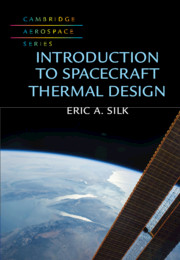Book contents
- Introduction to Spacecraft Thermal Design
- Cambridge Aerospace Series
- Introduction to Spacecraft Thermal Design
- Copyright page
- Dedication
- Contents
- Figures
- Tables
- Nomenclature
- Subscripts
- 1 Introduction
- 2 Conduction Heat Transfer Analysis
- 3 Radiative Heat Transfer Analysis
- 4 The Space Environment
- 5 Space-Based Advanced Thermal Conductance and Storage Technologies
- 6 Sensors, Instrumentation and Test Support Hardware
- 7 Fundamentals of Cryogenics
- 8 Developmental and Environmental Testing
- Book part
- Index
- Solutions
- References
6 - Sensors, Instrumentation and Test Support Hardware
Published online by Cambridge University Press: 19 June 2020
- Introduction to Spacecraft Thermal Design
- Cambridge Aerospace Series
- Introduction to Spacecraft Thermal Design
- Copyright page
- Dedication
- Contents
- Figures
- Tables
- Nomenclature
- Subscripts
- 1 Introduction
- 2 Conduction Heat Transfer Analysis
- 3 Radiative Heat Transfer Analysis
- 4 The Space Environment
- 5 Space-Based Advanced Thermal Conductance and Storage Technologies
- 6 Sensors, Instrumentation and Test Support Hardware
- 7 Fundamentals of Cryogenics
- 8 Developmental and Environmental Testing
- Book part
- Index
- Solutions
- References
Summary
In most engineering applications, physical measurements are relied upon to gauge the performance and state of health (SOH) of a system during operation, as well as to collect data. The level of detail for any measurement depends on how critical it is; it follows that determination of physical phenomena will only be as good as the quality of the measurements taken during the design, build, test and flight of space systems. Quality measurements providing insight into the SOH of the system, as well as phenomena occurring in the surrounding environment, can be used to identify performance issues should they arise. Sensors, instrumentation and test support equipment (ground based) are the tools used to validate system performance in a space-relevant environment prior to launch, as well as to perform measurements during actual space flight. This chapter provides an overview of the measurement technologies, guidelines and associated test hardware used in the test and operation of spaceflight systems.
- Type
- Chapter
- Information
- Introduction to Spacecraft Thermal Design , pp. 263 - 283Publisher: Cambridge University PressPrint publication year: 2020



